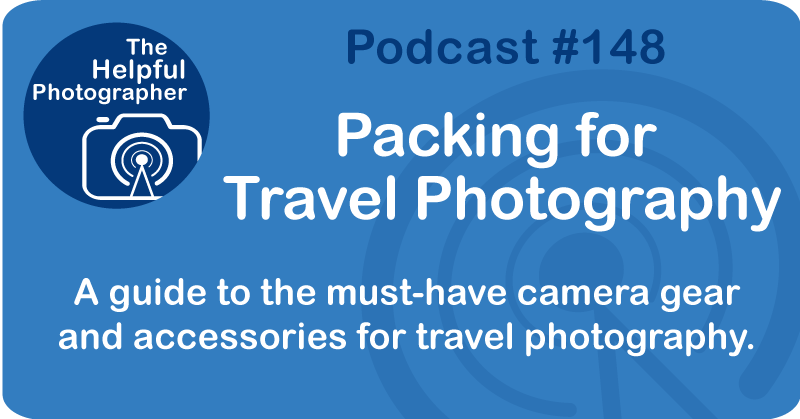Packing for Travel Photography #148

Last year, I hit a personal milestone, visiting my 65th country, and I can't remember ever traveling without my camera. The question I often get is this: other than your camera, what else do you carry?
Well, I always take my tripod and what photographers call the "Holy Trinity" of lenses. I went over the Holy Trinity in episode 118. Recently, I've also started bringing my 150 to 600mm lens, paired with a monopod for support. And it's not just for shooting wildlife! I'm finding that I'm using that long lens to shoot a lot of landscapes as well. Shocking, right? But it's a look I really enjoy.
I've also added neutral density filters and graduated neutral density filters to my bag. Interestingly enough, I no longer pack a flash. It just doesn't fit what I mostly shoot anymore. What I carry on a daily basis depends on what I'm planning to shoot. This is where all the research I talked about in the previous episode comes into play. Knowing what I'll be shooting helps me avoid overpacking and the inevitable back pain from lugging too much gear around.
Let's break down what's actually in my camera bag versus what I leave in the hotel. Starting with my camera bag, generally speaking, I'm always carrying the Holy Trinity. But the extra-long lens, the ND filters, and the tripod, monopod, and tabletop tripod? I only carry that if I absolutely know that I'm going to use that equipment that day.
Now, let's break down what's actually in my camera bag versus what I leave in the hotel. Starting with my bag, I always have one pen, one Sharpie, a microfiber cloth, and a small first aid kit. The kit includes band-aids, blister care, alcohol wipes, painkillers, and mosquito repellent wipes. I also carry a bottle of water. And I've attached an ultra-lightweight jacket to my bag. It's great for sun protection or for an extra layer when needed. I've got a rain cover for my camera bag, and I also pack a small Leatherman tool. And let's not forget… emergency cash, and my passport, which always stay in my camera bag. Since I never leave my bag behind, it's the safest place for these things. So those things are always in my bag, again, along with my camera and the Holy Trinity.
As for what stays in the hotel, that's where I leave my battery charger. I usually pack enough batteries to get me through the day, so I don't need to carry the extra weight. In my room, I keep a spare rear lens cap and a body cap because I once lost a rear lens cap in the floorboards of a boat and couldn't get it back and it left the rear side of my lens exposed for the rest of the trip—trust me, that's not an experience you want to repeat!
You'll probably notice I didn't mention front lens caps. That's because I don't use them. I know, I know, I know—it’s not typical, but they stress me out because I lose them. Instead, I rely on filters to protect my lenses, and Nisi's nearly shatterproof filters have been a game-changer for me.
In terms of cleaning supplies, I carry sensor swabs, cleaning fluid, and a blower for dust. I also pack Allen wrenches that aren't included in my multi-tool for any adjustments I might need to make to my tripod or trekking poles.
At the end of the day, I back up all of my images. For this, I bring two portable hard drives, plus extra cords to connect them to my laptop. I also pack additional charging cords for my phone and other devices. I carry extra cords, and yes, I said extra cords because you never know when one is going to fail—and they do fail!
I also make sure everything is charged overnight. I bring a power strip with at least four outlets, and here's a pro tip: bring a power strip with a three to five-foot cord. There's nothing worse than needing to charge your phone or laptop, but having the outlet across the room from the nightstand or desk.
Another travel tip: if you forget your USB brick or electrical adapter, many hotel TVs now have USB ports, and you can use that to charge your device. However, if you're charging a camera, it's probably not pulling enough power to do that. Just remember, some international electrical adapters only take two-prong plugs, but many US power strips have three prongs. So be sure to pack a three-prong to two-prong adapter and research which plug adapters you'll need for your destination.
Finally, I always, always always bring a poncho. I can't tell you how many times it's saved me in the past year. Even though I also carry a waterproof jacket, the poncho is extra useful for photographers because it covers everything—my camera, my bag—and it even gives me a dry space to change my lenses.
Pro tip: go for a light-colored poncho. That way, you'll have enough light underneath to see what you're doing when you're switching out gear. And don't forget a real first aid kit. You never know when you'll need it. I did say I carried a small first aid kit in my camera bag, but I have a real first aid kit in my hotel room.
I hope that helps you pack more effectively for your next trip.











